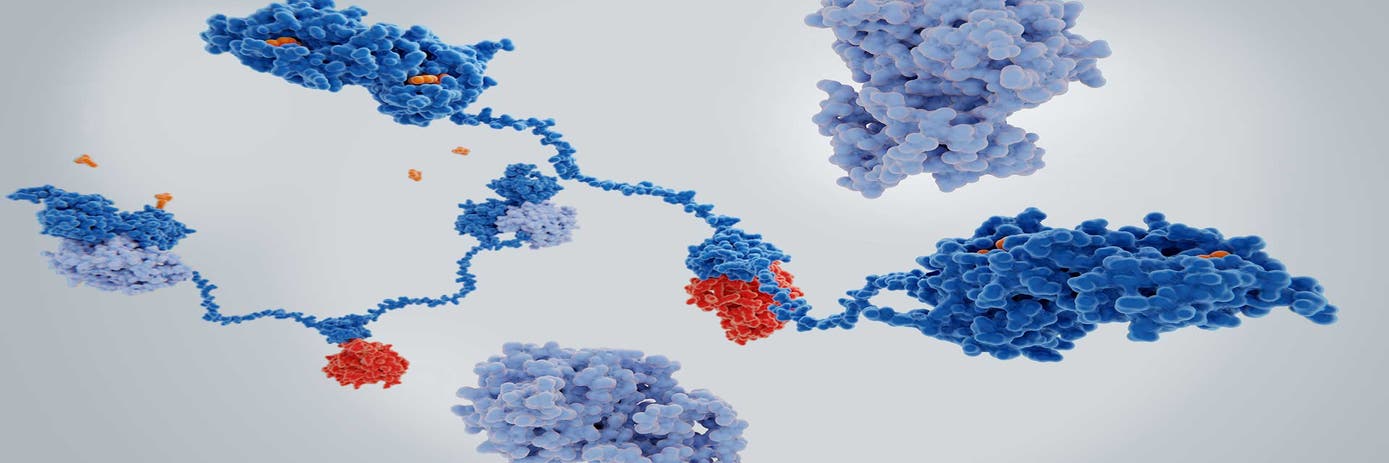The Human Kinome
The human kinome has 518 protein kinases, which contain 1.7% of human genes and approximately 20 lipid kinases.
These enzymes are an important class of drug targets as they play crucial roles in many cellular pathways. Their dysregulation can lead to major health issues, mainly cancers but also in the fields of neuroscience or autoimmune diseases.
In this article you will find kinase investigation examples related to different therapeutic areas and diseases, such as chronic myeloid leukemia and chronic pain treatment.
BCR-ABL1 fusion study in Chronic Myeloid Leukemia (CML)
Chronic myeloid leukemia (CML) is caused by a translocation of genetic material between chromosome 9 and 22. This translocation fuses part of the ABL1 gene from chromosome 9 with part of the BCR gene from chromosome 22, creating an abnormal fusion gene called BCR-ABL1. The abnormal chromosome 22, containing a piece of chromosome 9 and the fusion gene, is often referred to as the Philadelphia chromosome (named for the city where it was first discovered). BCR-ABL1 can promote cell proliferation and block apoptosis. However, unlike ABL1, it does not require signals in the cell to turn it on. The constantly active BCR-ABL1 protein signals cells to continue dividing abnormally and prevents them from self-destructing, which leads to overproduction of the abnormal cells and, eventually, to a shortage of normal blood cells.
The presence of the Philadelphia chromosome provides a target for molecular therapies in patients with chronic myeloid leukemia. In 2017, Sun et al found an imidazopyridazine-based compound called CT-721 as an inhibitor of WT BCR-ABL1 and T315I mutant (Sun et al., 2017). In this study, HTRF KinEase assay was used to analyze kinase enzyme activity and CT-721 compound inhibition activity
TrkA investigation for chronic pain treatment
In nociceptive neurons, nerve growth factor (NGF) has a central role in pain. Inflammation leads to the release of NGF and activation of tropomyosin receptor kinase A (TrkA), a tyrosine kinase coupled to the NGF receptor. NGF-binding leads to TrkA dimerization, auto-phosphorylation, and subsequent binding and activation of PLCγ.
A better understanding of TrkA mediated pain could lead to the development of analgesics with fewer side-effects than the currently used drugs. In 2017, Furuya et al. showed that a selective-TrkA inhibitor called A1 was specific and highly potent on this kinase (Furuya et al., 2017). In this study to determine the importance of the juxtamembrane region on A1 kinase inhibition, the kinase activity was easily assessed using HTRF KinEase assayTM.
For research use only. Not for use in diagnostic procedures.
References:
- Furuya, N., Momose, T., Katsuno, K., Fushimi, N., Muranaka, H., Handa, C., Ozawa, T., and Kinoshita, T. (2017). The juxtamembrane region of TrkA kinase is critical for inhibitor selectivity. Bioorg. Med. Chem. Lett. 27, 1233–1236.
- Sun, Y., Zhao, N., Wang, H., Wu, Q., Han, Y., Liu, Q., Wu, M., Liu, Y., Kong, F., Wang, H., et al. (2017). CT-721, a Potent Bcr-Abl Inhibitor, Exhibits Excellent In Vitro and In Vivo Efficacy in the Treatment of Chronic Myeloid Leukemia. J. Cancer 8, 2774–2784.

































